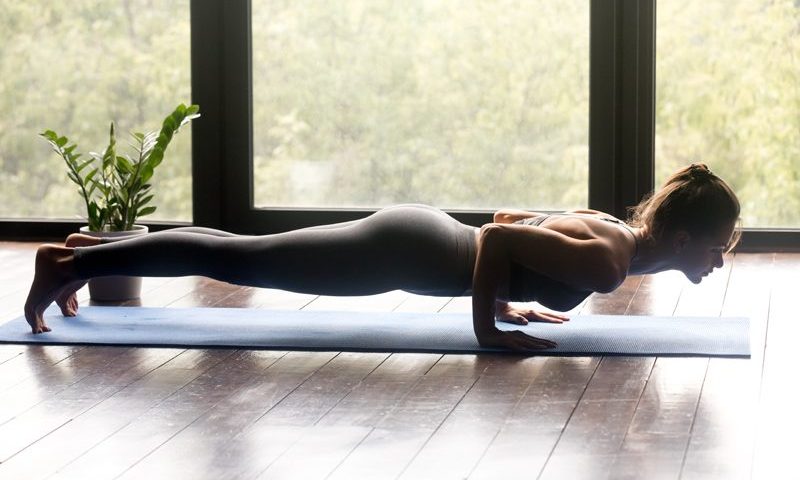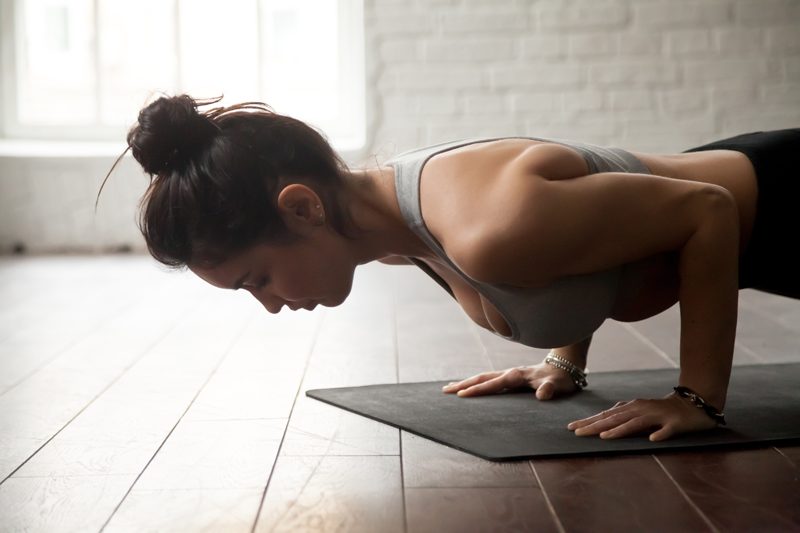
What Impact Does Yoga Have in Your Health?
May 28, 2019
Is Yoga Good for Losing Weight?
June 13, 2019How to do Chaturanga Dandasana

Chaturanga Dandasana, or Four-Limbed Staff Pose, is one of the most-renowned Ashtanga postures. The name derives from the Sanskrit words, Chatur, which means “four”, Anga, which means “limb”, Danda, which means “staff”, and Asana, which means “pose”. To practice Chaturanga Dandasana, you must first learn Kumbhakasana or Plank Pose. Once you can practice this comfortably, you’re ready to move onto Chaturanga. If you’re wondering how to do Chaturanga Dandasana, put on your yoga pants and keep reading.
Beginners Tip
If you’re new to yoga, Chaturanga Dandasana may be difficult to perform. Thankfully, the posture will become easier when your arms, back, and legs are strong enough to support you. To increase strength in these areas, practice Plank Pose daily. When you feel comfortable in this asana, it’s time to take things up a notch. Resume Plank position and begin to lower your knees to the floor. With an exhalation, lower your chest to within an inch or two above the mat. Remain in this position for as long as possible to build strength in the arms, back, and legs. After a few weeks, you should be ready to move onto Chaturanga Dandasana.
How to Practice Chaturanga Dandasana
- To practice Chaturanga Dandasana, begin in Plank Pose. Align your shoulders slightly ahead of your wrists and move onto the ball of your feet. As you do so, press the soles of your feet back as if they’re resting on a wall behind you.
- Next, push back through your heels to engage your quadriceps and lower body. Reach your sternum forward to create a straight line from the top of your head through your feet. Your entire body should now be parallel to the mat.
- Take a deep breath in and draw the top of your shoulders and thighs away from the floor. As you do so, pull your lower body up and in before releasing your tailbone towards the ground.
- As you breathe out, bend your elbows and draw them into your sides. Throughout the movement, your elbows should remain over your wrists. When you’re ready, gently lower yourself towards the mat, keeping your body straight throughout the process. For best results, avoid letting your center sag or your bottom rise toward the ceiling.
- Next, bring your gaze to the floor. Continue to lower your body until your shoulders are at the same height as your elbows.
- You are now in Chaturanga Dandasana. Continue to stretch through your heels, sternum, and the top of your head as you breathe. Hold the posture for around 2 minutes, remembering to breathe deeply.
- To exit the pose, breathe out and lower your stomach back down to the ground. Alternatively, move onto the tops of your feet and come into Upward Dog.
- If you want to deepen the pose, gently move from the balls of your feet onto the tops of your feet and shift your torso forward. This will allow your hands to rest beside your waist and increase the challenge of the posture.
Props
If you’re finding Chaturanga Dandasana tricky, don’t panic! Even experienced students struggle with this challenging pose. To make things easier, place a thickly rolled blanket underneath you before getting into Plank Pose. With the blanket parallel to your spine, lowering yourself onto it for support. For best results, use the support minimally; rest your body on it just enough to keep yourself in the position.

Modifications
If you’re struggling with Chaturanga, you may prefer a modified version. You can get a feel for the asana by practicing it standing upright. To do this, stand facing a wall with just a few inches of space in-between. Press your hands against the wall, slightly below the height of your shoulders. To engage your muscles, imagine you’re trying to push yourself away from the wall, but the firmness of your shoulder blades is preventing any movement. Finally, extend your spine by reaching the top of your head towards the ceiling and drawing your tailbone towards the floor.
Practice with a Partner
If you’re finding Chaturanga Dandasana tricky, practicing with a partner can also be helpful. A partner can help you to anchor your pelvis in the pose before lengthening the spine. To do this, perform Chaturanga, using a blanket for support if needed. Next, ask your partner to straddle your waist and squeeze the top of your pelvis with his/her lower legs. Your partner should then pull your pelvis back slightly towards your feet whilst you draw your upper body in the opposite direction.
Benefits
Chaturanga Dandasana has a range of great benefits including stronger arm, shoulder, abdominal and back muscles. It can also increase strength and flexibility in the wrists and tone the abdominal organs.
To practice Chaturanga Dandasana correctly you’ll need strength, coordination, and whole body alignment. With this in mind, the posture can help yogis learn how to balance effort and surrender in the pose. Seeking this balance can teach focus and concentration, or Dharana.
Chaturanga can also help yogis connect with their inner energy and strength. Although the pose may challenge students who lack self-belief, it can help them to overcome negative self-perceptions as they learn how to practice the asana correctly. Additionally, the posture is thought to stimulate the Manipura chakra, the energy center associated with confidence and self-esteem.
In Summary
Although Chaturanga Dandasana is a challenging posture, the benefits make it all worthwhile. For best results, put on your yoga bra and practice Chaturanga every day. After just a few weeks, your arms, shoulders, back and abdominal muscles should feel stronger, and the overall asana should become easier to practice.

